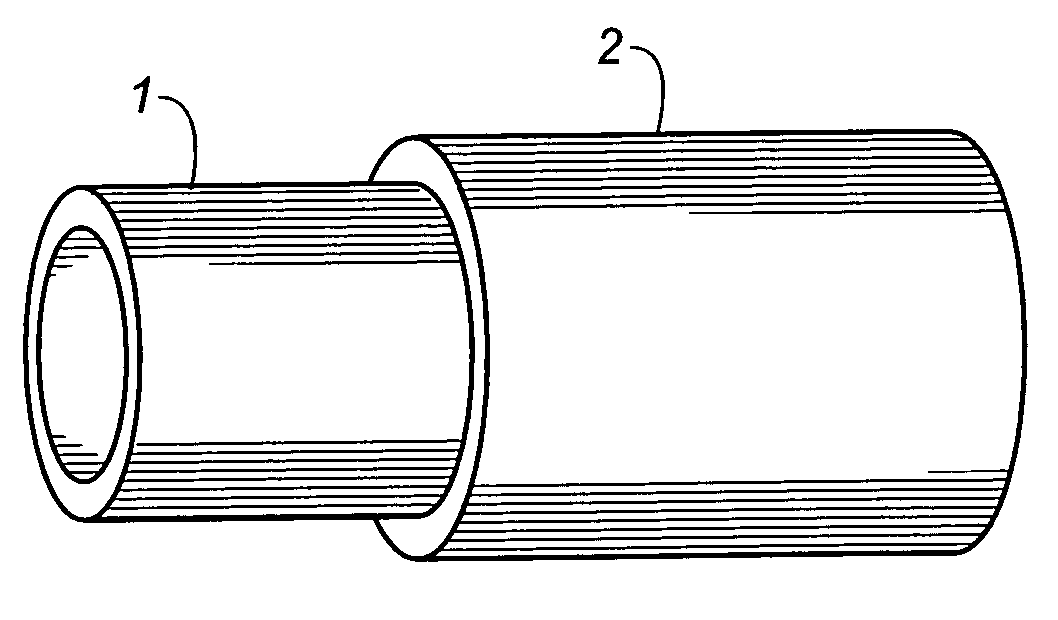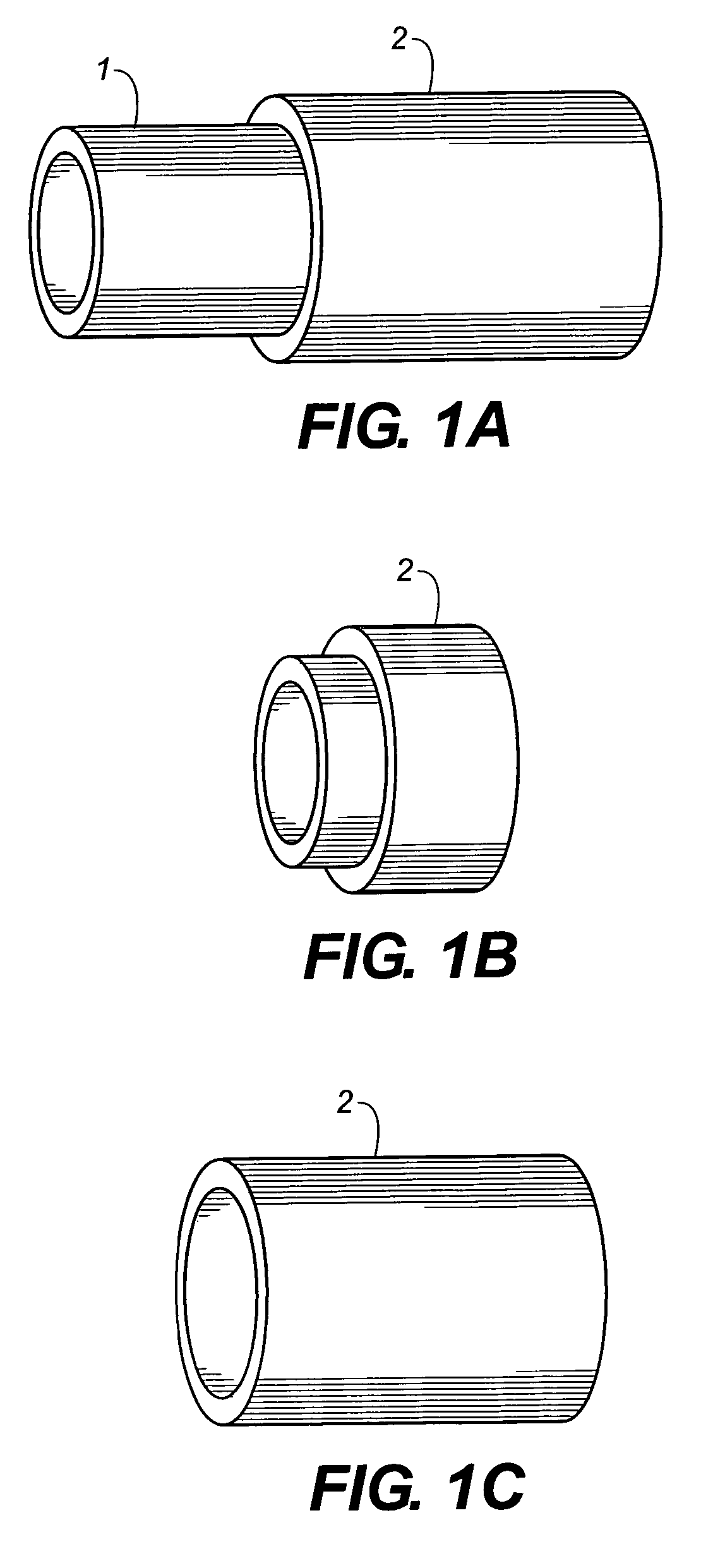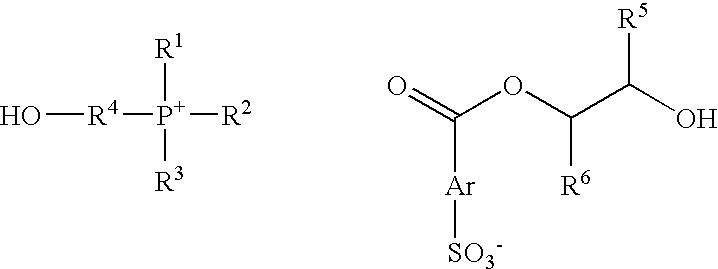Biasable transfer composition and member
a technology of composition and member, applied in the field of polymer, can solve the problems of bias voltage increase, deficiency in that both exhibit or possess relatively short electrical lives, and are still moisture sensitive polyurethane elastomers of this paten
- Summary
- Abstract
- Description
- Claims
- Application Information
AI Technical Summary
Benefits of technology
Problems solved by technology
Method used
Image
Examples
example 1
[0070] This example describes the preparation of a conductivity control agent useful in accordance with the invention, which is (2-hydroxyethyl)triphenylphosphonium(2-hydroxy-3-phenoxy)propyl 3-sulfobenzoate salt.
[0071] A mixture of 12.71 g (25 mmol) of (2-hydroxyethyl)triphenylphosphonium 3-sulfobenzoic acid, 3.75 g (25 mmol) of 1,2-epoxy-3-phenoxypropane was placed in a flask and heated under nitrogen in a 160° C. bath approximately 25 minutes and then for another approximately 1 hour at 170° C. The mixture was cooled and the product was isolated as an amorphous solid.
[0072] NMR spectrum (DMSO-d6) and MALD / I TOF MS spectra were consistent with the proposed structure.
[0073] Examples 2 and 3 describe the preparation of elastomeric polyurethane containing, as an additive, the conductivity control agent of the present invention, (2-hydroxyethyl)triphenylphosphonium(2-hydroxy-3-phenoxy)propyl 3-sulfobenzoate salt, at two concentrations, which correspond to 0.5 wt % of the total poly...
example 2
[0074] This example describes the preparation of a crosslinked 50 Durometer Shore A hardness elastomeric polyurethane containing, as an additive, a conductivity control agent of the present invention, (2-hydroxyethyl)triphenylphosphonium(2-hydroxy-3-phenoxy)propyl 3-sulfobenzoate Salt prepared according to Example 1.
[0075] To a one-liter plastic beaker containing 184.49 g (373.016 meq) of Terathane 1000, a poly(tetramethylene glycol) available from E.I. DuPont de Nemours Company, 2.250 g (6.832 meq) (2-hydroxyethyl)triphenylphosphonium(2-hydroxy-3-phenoxy)propyl 3-sulfobenzoate and 3 drops of a polydimethylsiloxane anti-foam agent obtained from Union Carbide under the trade name of SAG 47, were added 8.735 g (93.254 meq) of ethoxylated trimethylolpropane obtained commercially from Perstorp Specialty Chemicals under the trade name of polyol TP 30. The mixture was stirred and next, 254.529 g (473.102 meq) of a polyether-based polyurethane prepolymer obtained from Crompton Corporation...
example 3
[0076] This example describes the preparation of a crosslinked 50 Durometer Shore A hardness elastomeric polyurethane containing, as an additive, a conductivity control agent of the present invention, (2-hydroxyethyl)triphenylphosphonium(2-hydroxy-3-phenoxy)propyl 3-sulfobenzoate salt prepared according to Example 1.
[0077] To a one-liter plastic beaker containing 182.02 g (368.039 meq) of Terathane 1000, a poly(tetramethylene glycol) available from E.I. DuPont de Nemours Company, 4.50 g (13.663 meq) (2-Hydroxyethyl)triphenylphosphonium(2-Hydroxy-3-phenoxy)propyl 3-Sulfobenzoate and 3 drops of a polydimethylsiloxane anti-foam agent obtained from Union Carbide under the trade name of SAG 47, were added 8.62 g (92.010 meq) of ethoxylated trimethylolpropane obtained commercially from Perstorp Specialty Chemicals under the trade name of polyol TP 30. The mixture was stirred and next, 254.86 g (473.712 meq) of a polyether-based polyurethane prepolymer obtained from Crompton Corporation a...
PUM
| Property | Measurement | Unit |
|---|---|---|
| volume resistivity | aaaaa | aaaaa |
| resistivity | aaaaa | aaaaa |
| resistivity | aaaaa | aaaaa |
Abstract
Description
Claims
Application Information
 Login to View More
Login to View More - R&D
- Intellectual Property
- Life Sciences
- Materials
- Tech Scout
- Unparalleled Data Quality
- Higher Quality Content
- 60% Fewer Hallucinations
Browse by: Latest US Patents, China's latest patents, Technical Efficacy Thesaurus, Application Domain, Technology Topic, Popular Technical Reports.
© 2025 PatSnap. All rights reserved.Legal|Privacy policy|Modern Slavery Act Transparency Statement|Sitemap|About US| Contact US: help@patsnap.com



